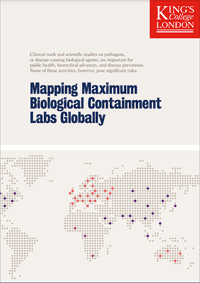Mapping Maximum Biological Containment Labs Globally
[Maximum Biocontainment]
The Mapping Maximum Biological Containment Labs Globally report from the Global Biolabs initiative tracked relevant information about about maximum containment facilities around the world, as of 2021 when it was published. Global Biolabs aims to increase public knowledge about these facilities and strengthen national and international biorisk management policies and practices.
SUMMARY
Global BioLabs: Mapping Maximum Biological Containment Labs Globally is an effort to increase public awareness about biosafety level 4 (BSL4) laboratories around the world. This report, from 2021, provides a map of BSL4 laboratories that are planned, under construction, and in operation, and identifies ways to measure the biosafety and biosecurity practices in the countries containing BSL4 laboratories. The report identified 59 maximum containment facilities, 36 of which are government run public health institutions. The report also draws attention to the fact that very few of the countries with laboratories have robust biosafety and biosecurity standards or dual use policies, and none have signed onto ISO 35001, a 2019 biorisk management standard. The report concludes with 5 key recommendations for increasing the safety and security of BSL4 laboratories.
The report was published by Global Biolabs, a collaboration between Gregory Koblentz at George Mason University and Filippa Lentzos at King’s College London. In addition to the report on the current state of BSL4 laboratories, Global Biolabs is engaged in advocacy for better international standards for biosafety and biosecurity, and have provided expertise at international meetings, such as the BWC meeting of experts in August 2021.


..png)
